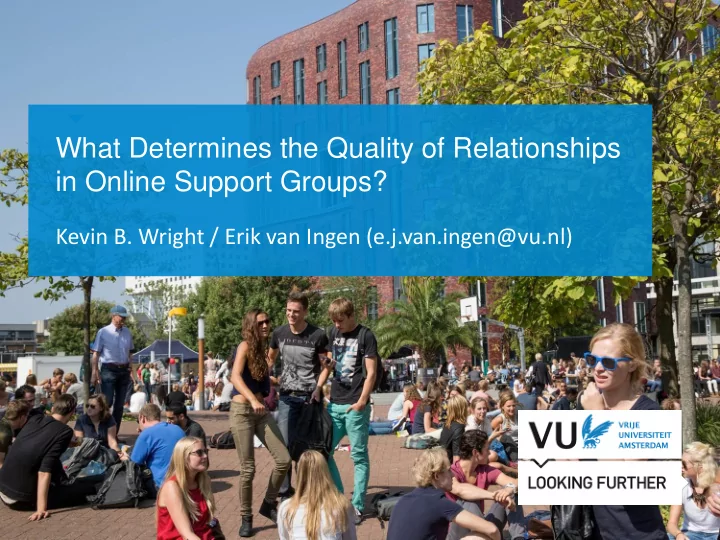

What Determines the Quality of Relationships in Online Support Groups? Kevin B. Wright / Erik van Ingen (e.j.van.ingen@vu.nl) ‹nr.› Het begint met een idee
PUZZLE OF ONLINE SUPPORT Social support needs strong ties? > (High) Trust, Effort Relations online support groups short-lived, weak (?) Yet… Online support groups very popular (> offline support groups) ‹nr.› Het begint met een idee 3 Faculty / department / title presentation 3 Het begint met een idee
RESEARCH QUESTIONS • Can health-related online support groups facilitate high-quality relationships? • What determines perceived quality of online relationships? ‹nr.› Het begint met een idee 4
PIERCE ET AL. (1991) QUALITY OF RELATIONSHIPS (QOR) INVENTORY Three dimensions: Supportiveness > Perceived support by other person > “To what extent can you count on this person to listen to you …?” Depth > Closeness, significance > “How significant is this relationship in your life?” (Conflict) > Negative emotions caused by other person 5 Erik van Ingen – Quality Online Relationships Vrije Universiteit Amsterdam
WHAT DETERMINES ONLINE QOR? Two central (relational) factors: Perceived similarity > Similarity -> Inter-personal attraction > Homophily -> Strengthens ties > Empathy, sense of belonging Self-disclosure (extent writing online) > OSD -> Quality of relationships > Emotional intensity -> strength tie 6 Erik van Ingen – Quality Online Relationships Vrije Universiteit Amsterdam
WHAT DETERMINES ONLINE QOR? Also individual characteristics: Willingness to Communicate about Health (WTCH) Weak-Tie Network Preference (WTNP) Age Women Some likely mediated by relational factors, e.g. • WTCH -> Extent writing -> QoR • Age -> Extent writing -> QoR 7 Erik van Ingen – Quality Online Relationships Vrije Universiteit Amsterdam
RESEARCH DESIGN • 126 participants online support groups E.g. alcoholism, cancer, drug abuse, disordered eating, HIV, etc. • 10 items supportiveness / depth dimensions QoR scale “How significant are your relationships with the members of your online support in your life?” (depth) Responses : (1) “Not at all”; (2) “A little”; (3) “Quite a bit”; (4) “Very much”. • Explanatory variables Perceived Attitudinal Similarity: 4 items, e.g. “The people I talk to most frequently in my online support group are similar to me” Extent Writing Messages (1 item) WTCH: 10 items, e.g. “I am comfortable talking about my health with a wide variety of people” WTNP: 15 items, e.g. “It is less risky to discuss my problems with people who are not as intimate with me as close friends and family members” 8 Erik van Ingen – Quality Online Relationships Vrije Universiteit Amsterdam
RESULTS Pierce et al (1991): m=2.87 for friendships Depth 2.66 Not at all A bit Quite a bit Very much Pierce et al (1991): Supportiveness m=3.28 for friendships 3.01 Not at all A bit Quite a bit Very much 9 Erik van Ingen – Quality Online Relationships Vrije Universiteit Amsterdam
RESULTS Figure 2 Intermediation model of QOR RMSEA .077; CFI .932; TLI .913 Note . WTCH= Willingness To Communicate about Health; WTNP= Weak-Tie support Network Preference. The measurement part of QOR is not shown. All path coefficients are significant at the p<.05 level (two-tailed). 10 Vrije Universiteit Amsterdam
Conclusions: The puzzle of online support • Online relationships fairly high quality • QoR online support groups one dimensional • Similarity and self-disclosure driving factors Similarity attitudes not background • Also explain individual differences 11
Thank you for your attention!
Recommend
More recommend